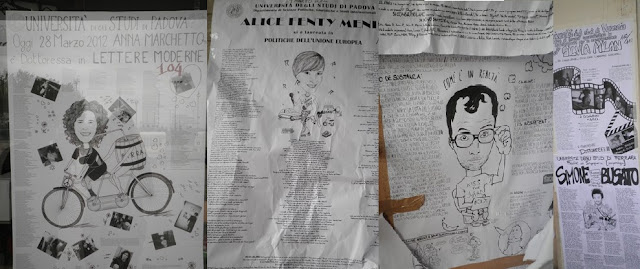Traditions in Rovigo
Tradition is alive and well in Italy; not only are old traditions maintained but new ones have been established. During my week in Rovigo I made note of a few:
A Baby is Born
When a baby is born a display is hung from the gates, door, balcony or window of the house, to announce the safe arrival of the child. Blue designates a boy and pink a girl. In Grignano Polesine there has been one of each born this week. It makes me smile when I walk past the houses, the families are proud of their new addition and without spending extortionate amounts of money share their joy with the rest of us. This is a tradition that I know is alive and well on the shores of Lago Maggiore as well as in the province of Rovigo. Friends of the family have displayed their news in a similar fashion. Long may it continue.
Graduation Announcements
Not an entry in a newspaper or a family party but posters displayed around the town to greet this news – and enlighten the public as to elements of the graduate’s past. Some of them are not for reading by ‘la Nonna ed il Nonno’ highlighting sexual encounters, perhaps an interest in light pharmaceuticals and other risqué episodes. They usually have at least one caricature of the graduate professionally drawn. Friends and family add their tales to the poster. It is an amusing reflection on the person’s life before the serious stuff starts – trying to earn money!
Attendance at Mass
This is a tradition that is dying out. The church bells continue to ring, urging those of us still in bed (albeit lying under a crucifix, rosary and the watchful eyes of a saint or two that have adorned the walls since the grandparents married) to get to church, confess our sins, ask for forgiveness, give thanks and then (in most cases) promptly go and do again what we had just apologised for. It was Palm Sunday when I was in town, and more people attended church than normal – such is the call of Holy Week. Men, women and children left church still clutching their palm fronds. They will probably dry and brown on a forgotten shelf in the pantry.
Looking After the Dead
Death is quickly dealt with in the south of Europe. Within a maximum of two days the body is buried or cremated, but they are not forgotten. November 1st, All Saint’s Day, Day of the Dead, call it what you will, it is a day when only the deceased who no longer have living relatives within the vicinity (and vicinity can mean 500 miles or more)are not visited. Picnics sometimes are held in the graveyards as time is spent remembering those who have departed, though that tradition does appear to be on the wane, graves are tended and flowers arranged. The cemeteries are a riot of colour. But it is not just the first day of November that is a day for visiting. As we cleaned the memorials to departed grandparents and aunt, cleaning the fake flowers that add colour when we are not around, and adding fresh, we may have been in a florist’s shop. There was colour everywhere. Very few memorials were flowerless. The nun’s memorial had flowers – and she did not have children to come to tend to her. Ancestors are an important and continuing part of the lives of living. Look to the future by all means, but do not forget where you come from.
From birth to death and all that lies in between the Italians have traditions. Life is a cycle and it is celebrated.



Comments
Post a Comment